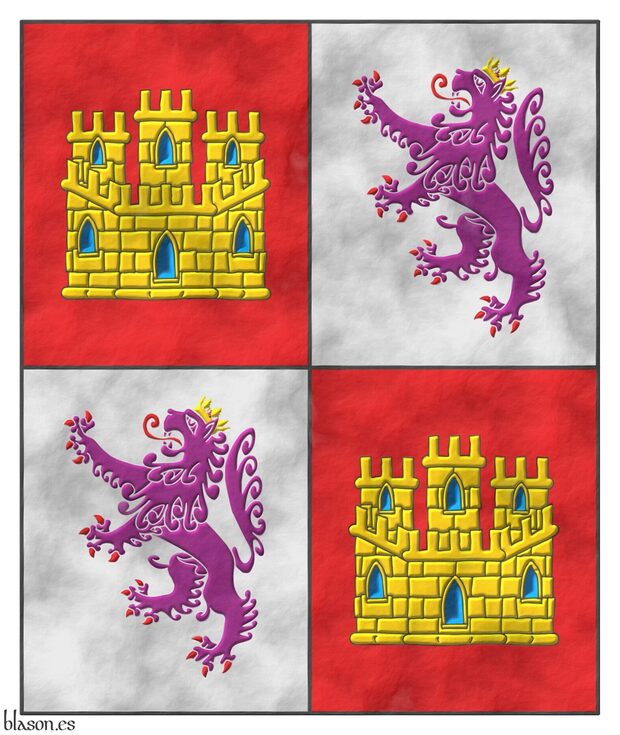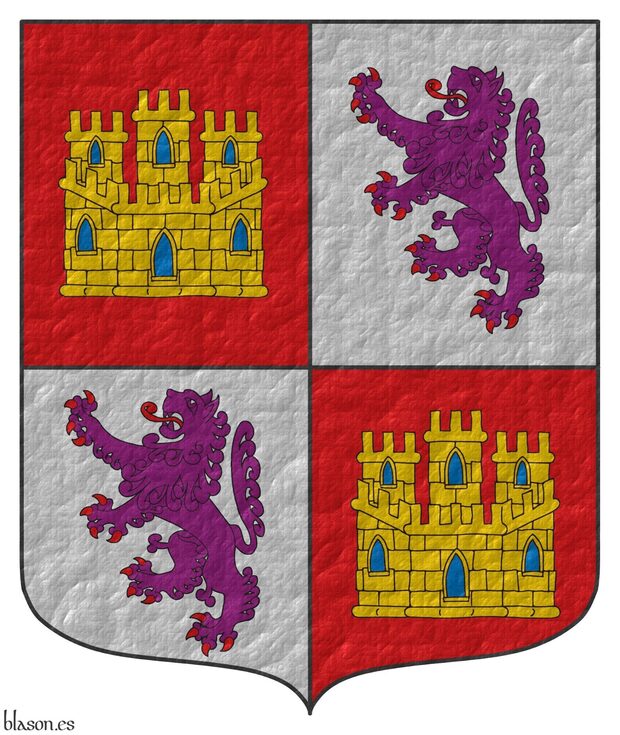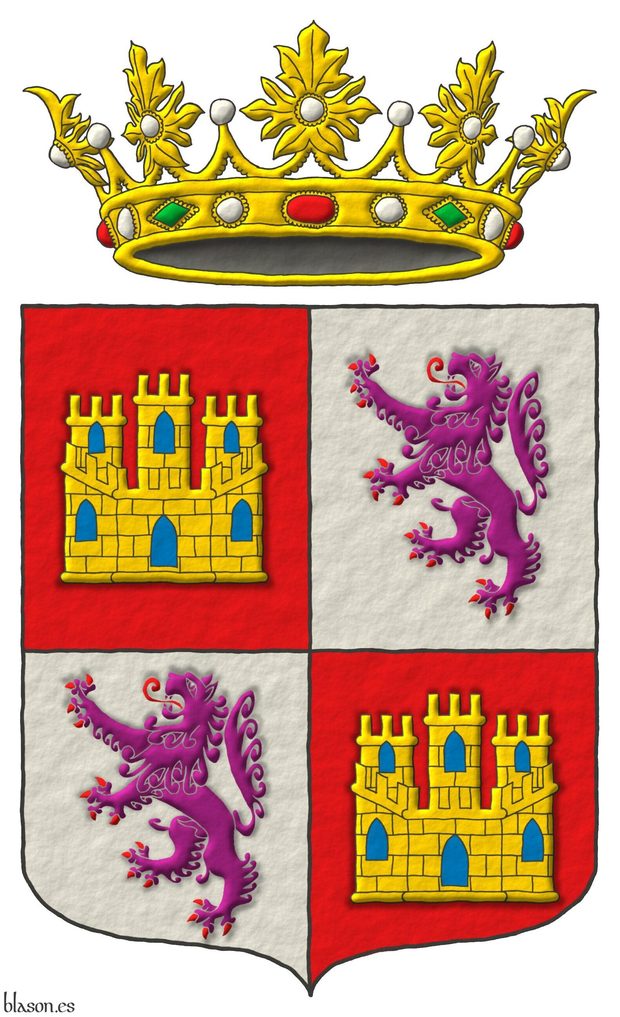Pendón de Castilla y León

Banner Quarterly: 1 and 4 Gules, a castle triple towered Or, port and windows Azure, masoned Sable; 2 and 3 Argent, a lion rampant Purpure, armed and langued Gules, crowned Or.
Pendón cuartelado: 1o y 4o de gules, un castillo de oro, aclarado de azur, mazonado de sable; 2o y 3o de plata, un león rampante de púrpura, armado y lampasado de gules, coronado de oro.
Pendón interpretado por mí como: un rectángulo de proporción entre su ancho y su alto de 5x6; el campo está esmaltado de tintas planas gules y plata; los 2 castillos y los 2 leones están iluminados; el león y su corona están delineados del campo; el castillo está mazonado de sable; y el conjunto tiene un acabado apergaminado.
Puede consultarse en el armorial para la coronación de [Eduardo IV de Inglaterra; 1461; columna 2, fila 25] un pendón de estas características, la razón de ello era la aspiración de Eduardo IV a este reino, aspiración procedente de sus predecesores.
Este armorial fue realizado por diferentes artistas y al que le correspondió hacer el pendón de Castilla y León parece que pintó los leones de oro, si bien este oro no es tan amarillo como el que esmalta los castillos, castillo que tienen 2 ventanas mínimas y una puerta aclarada de azur. Por esta diferencia de tonos entre leones y castillos cabría plantearse la hipótesis de una degradación de un esmalte púrpura original en un ocre.
Al comienzo del armorial también aparecen estos leones en una representación ecuestre de Eduardo IV donde un tono rosa podría recordar a un púrpura original y, por tanto, apoyar la hipótesis de la degradación.
Finalmente, hay una tercera aparición de estos leones en otro pendón que combina las armas de Castilla y León con las de Inglaterra. Donde el color de los leones es más parecido al del pendón que al de la representación ecuestre.
Blazon keywords: Quarterly, Gules, Or, Azure, Sable, One, Castle, Port and windows, Masoned, Argent, Purpure, Lion, Rampant, Armed, Langued and Crowned.
Style keywords: Illuminated, Rectangular and Old parchment.
Classification: Interpreted, Civic, Flag, Banner of arms, Kingdom of Castile and Leon and Canting.
Bearer: Castilla y León.


![Ver [Burke, B.; 1842] en referencias bibliográficas. Libro abierto, hojas de plata, filo de oro, guardas de gules, tapas de sable.](../css/Libro.Bibliografia.png)
Burke, B.; 1842
Sir Bernard Burke, C. B., LL. D., Ulster King of Arms, «The General Armory of England, Scotland, Ireland and Wales; Comprising a Registry of Armorial Bearings from the Earliest to the Present Time», Harrison, London, 1842.
Sir Bernard Burke, C. B., LL. D. (1814-1892), also cited as John Bernard Burke, was a British genealogist. He was son of the genealogist John Burke (1787–1848). In 1853, Sir Bernard Burke was appointed Ulster King of Arms.
I use to consult [Burke, B.; 1989] and [Burke, B.; 2009].
Bibliographical reference of century XIX.
Classification: In black and white and English language.
Author: Burke, Bernard.
The following articles cite this bibliographic reference:
External resource:

Alphonse X of Castile

Known as the Wise, King of Castile and Leon from 1252 to 1284.
Escudo cuartelado: 1o y 4o de gules, un castillo de oro, aclarado de azur, mazonado de sable; 2o y 3o de plata, un león rampante de púrpura, armado y lampasado de gules.
Quarterly: 1 and 4 Gules, a castle triple towered Or, port and windows Azure, masoned Sable; 2 and 3 Argent, a lion rampant Purpure, armed and langued Gules.
Armories of the Wise King of Castile interpreted by me with the following characteristics: the external shape of the coat of arms ends in an ogee arch; the field, the 2 castles, and the 2 lions are outlined and enameled in flat colors; and the texture seems fabric.
This coat of arms, but with a pointed external shape, can be seen in the 2nd part of the so-called armorial [Wijnbergen; 1265; cuat of arms number 1,289], with the title «Le roy Despaingne», which in this context is understood to refer to Castilla y León.
The 2nd part of this armorial was made between 1270 and 1285 and, being Alphonse X king of Castile and Leon from 1252 to 1284, it is to Him that the title «Le roy Despaingne» seems to refer.
Blazon keywords: Quarterly, Gules, Or, Azure, Sable, One, Castle, Port and windows, Masoned, Argent, Purpure, Lion, Rampant, Armed and Langued.
Style keywords: Ogee, Plain tincture, Outlined in sable and Fabric.
Classification: Interpreted, Personal, Coat of arms and Kingdom of Castile and Leon.
Bearer: Alphonse X of Castile.

Alphonse X of Castile, open royal crown

Escudo cuartelado: 1o y 4o de gules, un castillo de oro, aclarado de azur, mazonado de sable; 2o y 3o de plata, un león rampante de púrpura, armado y lampasado de gules. Timbrado de una corona real abierta.
Quarterly: 1 and 4 Gules, a castle triple towered Or, port and windows Azure, masoned Sable; 2 and 3 Argent, a lion rampant Purpure, armed and langued Gules. Crest: An open royal crown Or.
I emblazoned the coat of arms of the King with an external shape ending in an ogee arch, the field, castles, lions, and crown are outlined; and all have a crystal clear finishing.
Blazon keywords: Quarterly, Gules, Or, Azure, Sable, One, Castle, Port and windows, Masoned, Argent, Purpure, Lion, Rampant, Armed, Langued, Crest, Open royal crown and Crown.
Style keywords: Ogee, Plain tincture, Outlined in sable and Marmoreal.
Classification: Interpreted, Personal, Coat of arms and Kingdom of Castile and Leon.
Bearer: Alphonse X of Castile.


Ferdinand III of Castile

Son of Berenguela, Queen of Castile, and Alfonso IX, King of León.
Quarterly: 1 and 4 Gules, a castle triple towered Or, port and windows Azure, masoned Sable; 2 and 3 Argent, a lion rampant Purpure, armed and langued Gules.
Escudo cuartelado: 1o y 4o de gules, un castillo de oro, aclarado de azur, mazonado de sable; 2o y 3o de plata, un león rampante de púrpura, armado y lampasado de gules.
Arms of King Ferdinand III of Castile, as interpreted by me, with the following characteristics: the shield’s shape is rounded; the field, the two castles, and the two lions have been illuminated; and the whole composition features a watercolor finish.
It is with King Ferdinand III the Saint of Castile when «the emblematic system reaches its highest degree of perfection, acquiring two characteristics: realism, which becomes a hallmark of Spanish heraldry,... and the tendency to combine coats of arms» with the appearance of quarterly divisions replacing the cadency marks used in the rest of Europe [Valverde Ogallar, P. B.; 2001; page 100].
Shield in flat ink and illuminated metallic finish


Design of a heraldic document
Blazon keywords: Quarterly, Gules, Or, Azure, Sable, One, Castle, Port and windows, Masoned, Argent, Purpure, Lion, Rampant, Armed and Langued.
Style keywords: Semi-circular, Illuminated and Watercolor.
Classification: Interpreted, Personal, Coat of arms and Kingdom of Castile and Leon.
Bearer: Ferdinand III of Castile.


Ferdinand III of Castile, open royal crown

King of Castile from 1217 to 1252 and of León from 1230 to 1252.
Quarterly: 1 and 4 Gules, a castle triple towered Or, port and windows Azure, masoned Sable; 2 and 3 Argent, a lion rampant Purpure, armed and langued Gules. Crest: An open royal crown Or.
Escudo cuartelado: 1o y 4o de gules, un castillo de oro, aclarado de azur, mazonado de sable; 2o y 3o de plata, un león rampante de púrpura, armado y lampasado de gules. Timbrado de una corona real abierta.
Arms of the king, as interpreted as follows: the shield’s shape is pointed and rounded; the field, the castles, the lions, and the crown have been illuminated; only the castles and the lions have been shaded; and the whole composition features a raised-line finish.
Between the years 1217-1229, King Ferdinand III, before adopting this quarterly shield and when he was only King of Castile, in his seals «bears the arms of Leon (family arms) on the shield of the equestrian image and carries on the reverse the emblem of Castile (territorial sign)» [Menéndez Pidal de Navascués, F.; 1988; page 537].
Blazon keywords: Quarterly, Gules, Or, Azure, Sable, One, Castle, Port and windows, Masoned, Argent, Purpure, Lion, Rampant, Armed, Langued, Crest, Open royal crown and Crown.
Style keywords: Ogee, Illuminated, Shaded and Freehand.
Classification: Interpreted, Personal, Coat of arms and Kingdom of Castile and Leon.
Bearer: Ferdinand III of Castile.


Ferdinand III, invention of quartering

Quarterly: 1 and 4 Gules, a castle triple towered Or, port and windows Azure, masoned Sable; 2 and 3 Argent, a lion rampant Purpure, armed and langued Gules.
Escudo cuartelado: 1o y 4o de gules, un castillo de oro, aclarado de azur, mazonado de sable; 2o y 3o de plata, un león rampante de púrpura, armado y lampasado de gules.
A symbolic image representing, through 3 coats of arms, the creation of the coat of arms of the King Ferdinand III the Saint from the arms of Alfonso IX, King of León, and Berenguela, Queen of Castile. The shapes of all three shields are rounded; all their components are illuminated; and the whole composition features a watercolor finish.
Ferdinand III the Saint was the son of Alfonso IX of León and Berenguela of Castile. During his reign, the crowns of Castile and León were united forever. When, in 1230, Ferdinand III succeeded his father, he adopted a quarterly coat of arms, placing his mother's arms, the castle, in the 1st and 4th quarters, and his father's arms, the lion, in the 2nd and 3rd quarters. His goal was likely to achieve balance between the two kingdoms and to give his coat of arms a greater sense of continuity over time compared to impaled arms. The coat of arms of Ferdinand III the Saint was the first quarterly shield in history, and the idea spread into the heraldry of Spain and other kingdoms, such as Aragon-Sicily, Brabant, England, Navarre, and Bohemia.
The mother first, schematic in English
Blazon keywords: Quarterly, Gules, Or, Azure, Sable, One, Castle, Port and windows, Masoned, Argent, Purpure, Lion, Rampant, Armed, Langued, Crest, Open royal crown and Crown.
Style keywords: Semi-circular, Illuminated, Tilted shield and Watercolor.
Classification: Interpreted, Personal, Accolé arms, Family tree, Genealogical, Kingdom of Castile, Kingdom of León and Kingdom of Castile and Leon.
Bearer: Ferdinand III of Castile.


![Ver [Brault, G. J.; 1997] en referencias bibliográficas. Libro abierto, hojas de plata, filo de oro, guardas de gules, tapas de sable.](../css/Libro.Bibliografia.png)
Brault, G. J.; 1997

Gerard J. Brault, professor of French and Medieval Studies at Pennsylvania State University, «Rolls of Arms of Edward I, 1272-1307, Volume I and Volume II», is a set of 2 volumes, 1,104 pages, size 24.4 x 17.2 cm, with 3 color illustrations and 8 black and white illustrations, published by Boydell Press, Aspilogia series, ISBN 9780851156699, Suffolk, United Kingdom, May 1, 1997.
Another annotated edition exists from February 21, 2008, also published by Boydell Press.
The starting hypothesis of this book is that at the beginning of the second half of the 13th century, the use of coats of arms increased, this increase led to the appearance of the first armorials in which the names of their holders were recorded along with the descriptive blazon of their armory, and painted shields could be included.
From the Middle Ages, about 350 armorials have survived, of which 130 come from England, and they are a unique source for identifying many medieval figures, their titles, and their possessions. This book analyzes 17 of these armorials, such as the so-called [Marshal, L.; 1295; The Lord Marshal's Roll], which includes the coat of arms of William de Colebrand that illustrates this bibliographic reference.
Bibliographical reference of century XX.
The author is Brault, Gerard J..
The following articles cite this bibliographic reference:
External link:

Sigue por: Menéndez Pidal de Navascués, F.; 1988.
-
Language
-
Categories of heraldry
-
Divisions of the field
- Without divisions
- Party per pale
- Party per fess
- Party per bend sinister
- Tierce
- Tierce sinister
- Tierced per fess
- Tierced per bend
- Tierced pallwise inverted
- Quarterly
- Quarterly per saltire
- Gyronny
- Party per fess, the chief per pale
- Party per pale, the sinister per fess
- Party per fess, the base per pale
- Party per pale, the dexter per fess
- Chapé
- Chaussé
- Party per chevron
- Enté en point
- Flanched
-
Metals
-
Colours
-
Furs
-
Other tinctures
-
Ordinaries and sub-ordinaries
-
Diminutives of the ordinaries
-
Other charges
-
Charges from Nature
Water, Eagle, Bald eagle, Eagle claw, Dorsal fin, Tail fin, Two hands clasped, Lark, Tree, Trunk, Rainbow, Atom, Barbel, Acorn, Bighorn sheep, Arm, Owl, Vulture, Horse, Head, Goat, Camellia, Thistle, Merino ram, Kapok tree, Stag, Doe, Crescent, Increscent, Chrysanthemum, Tail, Tail addorsed, Ermine spot, Hummingbird, Snowflake, Heart, Roe deer, Neck, Roe deers' attires, Raven, Dolphin, Diamond, Tooth, Elephant, Emerald, Starling, Mullet, Mullet of four points, Star of David, Estoile, Male figure, Fleur de lis, Flower, Cornflower, Dogwood flower, Lotus flower, Hop cone, Bluebonnet, Puffin, Ash, Rooster, Claw, Talon, Goose, Heron, Seagull, Pomegranate, Sunflower, Swallow-tail, Falcon, Leaf, Boar, Goldfinch, Laurel, Barn owl, Lion, Lioness, Lion passant, Leopard, Lion rampant guardant, Lynx, Lily, Madonna lily, Flame, Wolf, She-wolf, Parrot, Moon, Hand, Apple, Apple tree, Martlet, Wing, Two wings in vol, Covert, Blackbird, Mount, Trimount, Fly, Wrist, Elm, Olive tree, Orbital, Bear, Palm frond, Palm tree, Dove, Poplar leaf, Jaguar, Paw, Forepaw, Foot (palmiped), Foreleg, Peacock, Chest, Pelican, Pelican in her piety, Dog, Brach hound, Fish, Hoof, Beak, Quill, Cinquefoil, Quetzal, Branch, Sprig, Frog, Shamrock, Caboshed, Oak, Holm oak, Rose, Double rose, Savage, Serpent, Plough of Ursa Major, Sun, Sun in splendour, Ray of the sun, Stem, Badger, Tyger, Linden, Wheat, Wheat spike, Bull, Tulip, Udder, Escallop and Fox.
-
Artificial charges
Halberd, Plough share, Ace of spades, Anchor, Cyclamor, Torch, Bow, Arch, Harp, Non-classic artifact, Winnowing fan, Crozier, Conductor's baton, Pair of scales, Ship, Norman ship, Beret, Grenade, Ecclesiastical cap, Arm vambraced, Chain, Covered cup, Monstrance, Bell, Bell tower, Cannon dismounted, Carbuncle, Castle, Clarion, Nail, Cord, Dagger, Key ward, Turret, With a turret, Armillary sphere, Sword, Sabre, Parchment, Scroll, Arrow, Club, Garb, Sheaf of tobacco, Scythe, Gauntlet, Axe, Buckle, Galician granary, Polish winged hussar, Church, Oil lamp, Spear, Spear's head, Fleam, Letter, Book, Open book, Closed book, Bookmark, Page, Line, Lantern, Key, Four crescents joined millsailwise, Hammer, Menorah, Mortar, Pestle, Number, Knot, Celtic Trinity knot, Water-bouget, Comb, Piano, Millstone, Millrind, Millwheel, Clay pot, Bridge, Cuffed, Hourglass, Chess rooks, Compass rose, Rosette of acanthus leaves, Mullet of six points pierced, Broken, Portcullis, Wheel, Wagon-wheel, Symbol, Sackbut, Drum, Tower, Trident, Trumpet, Double vajra and Anvil.
-
Immaterial charges
Angel, Heart enflamed, Sacred Heart of Jesus, Paschal lamb, Dragon, Wyvern, Phoenix, Garuda, Griffin, Sea-griffin, Winged hand, Our Lady of Mercy, Pegasus, Saint George, Mermaid, Trinity, Triton, Golden fleece, Unicorn and Ouroboros.
-
External elements
-
Heraldic creations
-
References
-
Formats
-
Keywords on this page
Port and windows, Watercolor, Alphonse X of Castile, Point upwards, Old parchment, Armed, Azure, Flag, Bibliography, Castilla y León, Castle, Crest, Ogee, Crown, Open royal crown, Crowned, Quarterly, Outlined in sable, In black and white, In fess, Fabric, Coat of arms, Accolé arms, Sword, Ferdinand III of Castile, Genealogical, Personal, Gules, Illuminated, Interpreted, Langued, English language, Lion, Lineage, Marmoreal, Masoned, Semi-circular, Or, Canting, Banner of arms, Argent, Without divisions, Purpure, Rampant, Kingdom of Castile and Leon, Sable, Century XX, Plain tincture and One.

